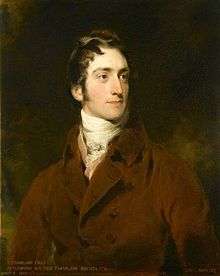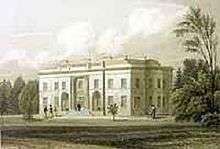Sir Robert Frankland-Russell, 7th Baronet
Sir Robert Frankland-Russell, 7th Baronet (1784–1849) was an English politician, known also as an artist. In early life he was called Robert Frankland.

Life
He was the son of Sir Thomas Frankland, 6th Baronet and his wife Dorothy, daughter of William Smelt. He studied at Christ Church, Oxford.[1]
Frankland was elected to parliament for Thirsk in 1815, resigning his seat in 1834. He succeeded his father as baronet in 1831, and in 1836 inherited property from Sir Robert Greenhill-Russell, 1st Baronet, adding Russell to his surname.[2][3] The estate included Chequers Court, which he improved, with Edward Buckton Lamb brought in as architect.[4][5] He was High Sheriff of Yorkshire in 1838.[6]


After her husband's death, Lady Frankland-Russell commissioned his friend Lamb to redesign All Saints parish church at Thirkleby, near the family seat Thirkleby Hall, in his memory.[4][7]
Works
Frankland-Russell's father had studied under John Malchair, and he himself was a watercolourist,[8] and painted hunting scenes.[9] Two series of aquatints by Charles Turner after Frankland appeared in 1814, Delights of Fishing and Hunting Subjects.[10]

Family
Frankland married in 1815 Louisa-Anne Murray, third daughter of Lord George Murray. They had five daughters. On the 7th baronet's death, the title passed to his cousin Frederick William Franklin.[3]
The daughters were:[11]
- Augusta-Louisa, who married Thomas de Grey, 5th Baron Walsingham in 1842, and was mother of Thomas de Grey, 6th Baron Walsingham, dying in 1844[12]
- Caroline-Agnes (d. 18 May 1846)
- Emily-Anne, who married Sir William Payne-Gallwey, 2nd Baronet in 1847[13]
- Julia-Roberta, who married Ralph Neville[14]
- Rosalind-Alicia, who married Francis L'Estrange Astley, son of Sir Jacob Astley, 5th Baronet, in 1854 as his second wife.[15]
Notes
- "Frankland, Robert (1784-1849), of Thirkleby, Yorks., History of Parliament Online". Retrieved 18 May 2015.
- "No. 19466". The London Gazette. 14 February 1837. p. 350.
- Sylvanus Urban (1849). The Gentleman's Magazine. p. 540.
- "Frankland, Robert (1784-1849), of Thirkleby Park, Yorks. and 15 Cavendish Square, Mdx., History of Parliament Online". Retrieved 18 May 2015.
- Guy McDonald (2 February 2004). England. New Holland Publishers. pp. 426–. ISBN 978-1-86011-116-7.
- William Grainge (1859). The Vale of Mowbray: A Historical and Topographical Account of Thirsk and Its Neighbourhood. Simpkin, Marshall, and Company. p. 108.
- Thomas Gill (1852). Vallis Eboracensis: Comprising the History and Antiquities of Easingwold and Its Neighbourhood. Simpkin, Marshall & Company. p. 337.
- H. L. Mallalieu (1986). The Dictionary of British Watercolour Artists up to 1920. Antique Collectors' Club. p. 134. ISBN 978-1-85149-025-7.
- Ian Waites (2012). Common Land in English Painting, 1700-1850. Boydell Press. p. 20. ISBN 978-1-84383-761-9.
- Sarah Treverbian Prideaux (1909). "Aquatint Engraving; a chapter in the history of book illustration". Internet Archive. p. 354. Retrieved 18 May 2015.
- John Burke (1838). A General and Heraldic Dictionary of the Peerage and Baronetage of the British Empire by John Burke. Henry Colburn. pp. 401–.
- Edmund Lodge (1858). The Peerage of the British Empire. p. 576.
- Edmund Lodge (1859). The Peerage and Baronetage of the British Empire. p. 705.
- The Annual Register: Or a View of the History, Politics and Literature, for the Year 1845. J. Dodsley. 1846. p. 223.
- The Marquis of Ruvigny and Ranieval (1 May 2013). The Plantagenet Roll of the Blood Royal: The Mortimer-Percy Volume. Heritage Books. p. 422. ISBN 978-0-7884-1872-3.
External links
| Parliament of the United Kingdom | ||
|---|---|---|
| Preceded by Robert Greenhill-Russell William Frankland |
Member of Parliament for Thirsk 1815–1834 With: Sir Robert Greenhill-Russell 1815–1832 |
Succeeded by Samuel Crompton |
| Baronetage of England | ||
| Preceded by Thomas Frankland |
Baronet (of Thirkleby) 1831–1849 |
Succeeded by Frederick Frankland |